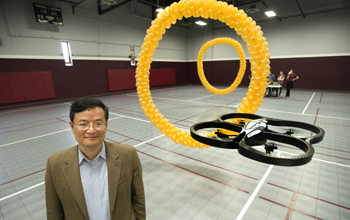Multimedia Gallery
Mind-controlled flying robot (Image 2)
Researchers from the lab of biomedical engineering professor Bin He of the University of Minnesota's (U of M) College of Science and Engineering demonstrate a new noninvasive system that allows people to control a flying robot using only their mind. Seated at the table are, from left to right, Brad Edelman, a graduate student in biomedical engineering; Alex Doud, a medical student and biomedical engineering graduate student. Standing left to right are Karl LaFleur, a recent bachelor's degree graduate in biomedical engineering; Bryan Baxter, a biomedical engineering Ph.D. student; and Kaitlyn Cassady, a laboratory staff member.
Working in He's lab (He pioneered the new technology), the researchers learned to use their thoughts to steer the robot around a gym, making it turn, rise, dip and even sail through a ring. The technology may one day enable people who have lost speech and mobility due to neurodegenerative diseases to regain function by controlling artificial limbs, wheelchairs or other devices using only their mind. The technology is completely noninvasive. Brain waves (EEG) are picked up by the electrodes of an EEG cap on the scalp, not a chip implanted in the brain.
To read more about this research and view a movie showing the technology in use, see the U of M news story Mind over mechanics. [Research supported by NSF grants CBET 09-33067 and DGE 10-69104.]
(Date of Image: June 2013) [See related image Here.]
Credit: University of Minnesota
See other images like this on your iPhone or iPad download NSF Science Zone on the Apple App Store.
Images and other media in the National Science Foundation Multimedia Gallery are available for use in print and electronic material by NSF employees, members of the media, university staff, teachers and the general public. All media in the gallery are intended for personal, educational and nonprofit/non-commercial use only.
Images credited to the National Science Foundation, a federal agency, are in the public domain. The images were created by employees of the United States Government as part of their official duties or prepared by contractors as "works for hire" for NSF. You may freely use NSF-credited images and, at your discretion, credit NSF with a "Courtesy: National Science Foundation" notation.
Additional information about general usage can be found in Conditions.
Also Available:
Download the high-resolution JPG version of the image. (6.1 MB)
Use your mouse to right-click (Mac users may need to Ctrl-click) the link above and choose the option that will save the file or target to your computer.

